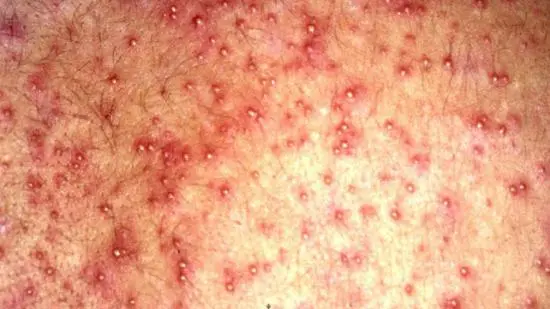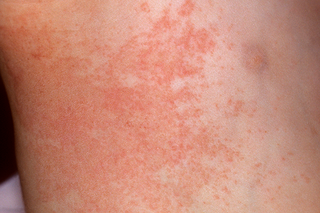Heat rash is medically known as miliaria. It is also known as eccrine miliaria or prickly heat or sweat rash. It is a skin condition triggered by blocked eccrine sweat glands and ducts, causing the backflow of eccrine sweat into the dermis and epidermis. This condition is characterized by an itchy rash, which is made up of small, red raised spots that cause a prickly or stinging sensation. It is most common in warm, humid climates during the summer months. The heat rash is usually self-limited and resolves independently of treatment.
CAUSES OF HEAT RASH
Prickly heat rash can be caused by inordinate perspiration, generally seen in hot, sticky climates. This inordinate perspiration can make it easier for dead skin cells as well as bacteria to block the body’s sweat glands, in turn causing a hedge of feathers to be formed, which traps the sweat under the skin. This condition also results in the sweat erecting up under the skin, in turn resulting in the characteristic bumps of this condition being seen. As the bumps begin to burst and release the trapped sweat, the case can suffer from a prickly, or surcharging sensation that gives this condition its name.
SYMPTOMS OF HEAT RASH
In most cases, heat rash has fairly common symptoms that one can look out for, which are typically limited to the conformation of small, itchy red bumps, which may feel prickly, surcharging, or burning. Still, in certain cases, it’s important to seek medical discussion if
1)The heat rash being suffered from doesn’t go down on its own within many days.
2) An existent, or someone an individual knows, begins to develop an infection in an area where an individual lately had a heat rash.
PREVENTION AND TREATMENT
It’s important to not scratch the rash. Scratching can lead to further vexation and conceivably an infection.
1) Cold baths and Shower: eccrine rash generally eases up after the skin is cooled down. Bathing in cool water can help with this. Washing the skin gently can also unclog the pores. This is pivotal since congested pores contribute to heat rash.
2) Suckers and Air Conditioners: While the skin heals, avoid excessive sweating and sticky air. Ventilation is important in letting the rash dry out and stay cool. Stay in an air-conditioned room, or use an air addict.
3) Light, humidity- Wicking Clothes: As the skin heals itself, it’s essential to avoid apparel that irritates the skin or makes an individual sweat more. Humidity-wicking apparel that’s light and loose-fitting can help the skin heal without galling it.
4) Ice Packs or Cold Clothes: Cold compresses are great for soothing bothered skin. Face cloths soaked in cold water, or ice wrapped in a cloth, can reduce the pain and irritation associated with heat rash.
5) Oatmeal: It’s effective at reducing itching and inflammation. This makes it a useful home remedy for heat rash and many other skin conditions.
6) Antihistamines: OTC antihistamines whether topical or oral can relieve the itching associated with heat rash. If existence is giving an antihistamine to a child, be sure to talk to the pediatrician or druggist about which types are stylish.
7) Sandalwood: exploration suggests sandalwood is anti-inflammatory and analgesic, meaning it may reduce pain. Sandalwood grease paint mixed with a little water and applied to the rash can reduce the burning, painful sensation associated with heat rash.
8) Baking Soda( Sodium Bicarbonate): It can soothe itchy skin. It’s also a commodity utmost of us in our closet. This makes it a great home remedy for heat rash and other itchy skin conditions. Add 3 to 5 teaspoons of baking soda pop to a lukewarm bath and soak for about 20 mins.
9) Aloe Vera: It’s an anti-inflammatory and antiseptic that can cool down the skin while precluding infections. This can help soothe swelling and pain. Use aloe vera gel directly on the heat rash to relieve the discomfort.
10) Unscented Talcum powder: Talcum reduces sweat by absorbing perspiration. In turn, this ensures the pores aren’t blocked. Use unscented talcum grease paint, as scents might irritate the skin. Apply a little on sweat-prone areas like the underarms, tails of the knees, and inner shanks. Cover the skin and let it sit like an antiperspirant deodorant.
11) Neem( Margosa): It can be used on several skin rashes. Research has shown it has antimicrobial and anti-inflammatory parcels. Still, mortal studies are limited.
12) Calamine lotion: It has several benefits for the skin, incompletely because it contains zinc oxide. It can help treat heat rash by soothing itchiness. Dab roughly calamine lotion onto the rash using a cotton pad. Reapply as demanded.
13) Epsom Salt( Magnesium Sulphate): It has various claimed health benefits. According to anecdotal accounts, a lukewarm bath with a mug or two of Epsom swabs may relieve itchiness.
14) Hydrocortisone Cream: It can be used to relieve heat rash. It’s available over the counter at any drugstore and can be applied once or twice a day to soothe itching.


